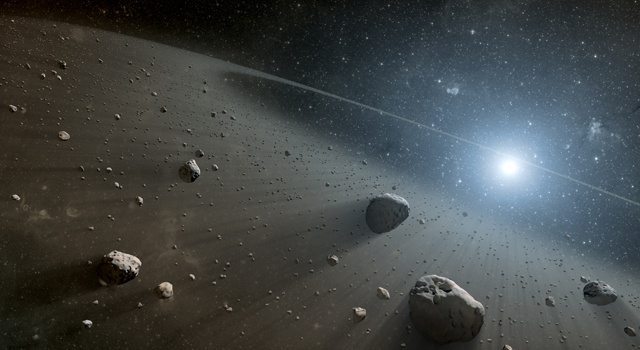
The asteroid main belt lies between the orbits of Mars and Jupiter in a range of semimajor axis 2.0-4.0 AU. It consists of more than 500,000 asteroids. Evidently, collisional and destructive processes were very common during the main belt’s history. The remnants of these processes are the asteroid families.
Asteroid families are groups of minor planets that have very similar orbits. It is supposed that they have a common origin, but their manner of origin may be different. Very young asteroid families (VYF) with a lesser age have been recently discovered. (First notes about such families are dated 2008). There are about 10 VYFs with an age of <1 Myrs that are known and studied very intensively.
Commonly, the angular orbital elements (node and perihelion longitudes) change with the age of the family nonlinearly due to the non-gravitational Yarkovsky effect. However, in the very young asteroid families, younger than 1.6 Myrs, this dependence is very close to linear. This means that non-gravitational forces have a relatively small effect on VYF dynamics. For this reason, the methods of studying VYFs may be different relative to older families.
In our recent work, we examined new methods for studying VIFs — the calculation of components of relative velocity during backward numerical integration. The normal component of velocity is most useful because it slowly depends on short periodic variations of orbits.
For most VYFs, the calculation of the normal component of relative velocity using backward numerical integration confirms their ages, obtained by orbital elements’ convergence method. In some cases, our method can reduce the range of age estimations.
The method may be successfully applied not only to families with members n>2, but also for pairs of asteroids. Our study (6070), Rheinland, and (54827) 2001 NQ8 pair are in fine agreement with the other authors’ results. Some other applications for known VYFs (Brugmansia family) and pairs (87887 (2000 SS286) and 415992 (2002 AT49) give an excellent result.
But studying relative velocity in VYFs is important not only for the family age estimation. The studied value of relative velocity may contain information about the ejection velocity. At least, it is easy to compare the velocity components in an orbital plane (Vxy) and normal ones (Vz). But for successful breakup velocity field reconstruction, the proper elimination of short periodic perturbations is required. It may be the goal of future studies. Another interesting problem in which this method may be useful is the reconstruction of the geometry of a breakup.
VYFs have very small values of the minimal relative velocities, about 1 m/s or smaller. For their origin, a very specific model of rotational fission is supposed (Pravec et al, Scheeres et al). According to this point of view, fast-rotating, asymmetric asteroids may lose part of their mass in the equatorial plane. When the rotation parameters of asteroids are known, our method can help to verify this hypothesis.
We can conclude that in combination with other methods, the calculation of the relative velocity of members of very young asteroid families can provide significant success in our understanding of the process of asteroid fragmentations.
However, not all VYFs are easy to study. The cases of the Datura, Kapbos, and Lucascavin family are complicated by different resonance perturbations. In some families, subsequent collisions and fragmentations are possible.
Finally, we can say that studying very young asteroid families is an interesting and perspective part of Solar System astronomy.
These findings are described in the article entitled On relative velocity in very young asteroid families, recently published in the journal Icarus. This work was conducted by Rosaev A. from Yaroslavl State University and Plávalová E. from the Slovak Academy of Science.









